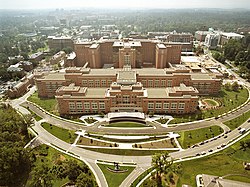
Back معاهد الصحة الوطنية الأمريكية Arabic Milli Səhiyyə Agentliyi Azerbaijani Национални институти по здравеопазване Bulgarian National Institutes of Health Catalan پەیمانگا نەتەوەییەکانی تەندروستی ولایەتە یەکگرتووەکان CKB Národní instituty zdraví Czech National Institutes of Health Danish National Institutes of Health German Εθνικά Ινστιτούτα Υγείας (ΗΠΑ) Greek Nacia Instituto pri Sano Esperanto
 Logo | |
 Aerial photo of the NIH Mark O. Hatfield Clinical Research Center in Bethesda, Maryland | |
| Agency overview | |
|---|---|
| Formed | August 1887 |
| Preceding agency |
|
| Headquarters | Bethesda, Maryland, U.S. 39°00′09″N 77°06′16″W / 39.00250°N 77.10444°W |
| Employees | 18,478 (2021), [1] |
| Annual budget | $45 billion (2022) |
| Agency executive |
|
| Parent agency | Department of Health & Human Services |
| Child agencies | |
| Website | nih.gov |
The National Institutes of Health (NIH) is the primary agency of the United States government responsible for biomedical and public health research. It was founded in 1887 and is now part of the United States Department of Health and Human Services. Many NIH facilities are located in Bethesda, Maryland, and other nearby suburbs of the Washington metropolitan area, with other primary facilities in the Research Triangle Park in North Carolina and smaller satellite facilities located around the United States. The NIH conducts its own scientific research through the NIH Intramural Research Program (IRP) and provides major biomedical research funding to non-NIH research facilities through its Extramural Research Program.
As of 2013[update], the IRP had 1,200 principal investigators and more than 4,000 postdoctoral fellows in basic, translational, and clinical research, being the largest biomedical research institution in the world,[1] while, as of 2003, the extramural arm provided 28% of biomedical research funding spent annually in the U.S., or about US$26.4 billion.[2]
The NIH comprises 27 separate institutes and centers of different biomedical disciplines and is responsible for many scientific accomplishments, including the discovery of fluoride to prevent tooth decay, the use of lithium to manage bipolar disorder, and the creation of vaccines against hepatitis, Haemophilus influenzae (HIB), and human papillomavirus (HPV).[3]
In 2019, the NIH was ranked number two in the world, behind Harvard University, for biomedical sciences in the Nature Index, which measured the largest contributors to papers published in a subset of leading journals from 2015 to 2018.[4][5]
- ^ "Organization and Leadership | NIH Intramural Research Program". Irp.nih.gov. April 4, 2011. Archived from the original on April 24, 2013. Retrieved April 28, 2013.
- ^ Osterweil, Neil (September 20, 2005). "Medical Research Spending Doubled Over Past Decade". MedPage Today. Archived from the original on October 16, 2015. Retrieved September 15, 2015.
- ^ "NIH Intramural Research at the Threshold of a New Era" (PDF). NIH Sourcebook. Archived from the original (PDF) on January 5, 2012. Retrieved January 20, 2012.
- ^ "The top 10 institutions in biomedical sciences in 2018". Nature Index. May 17, 2019. Retrieved May 28, 2019.
- ^ "Introduction to the Nature Index". Nature Index.